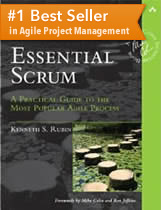Scrum Framework: Chapter 2
Core Scrum Framework
Scrum is a refreshingly simple, people-centric framework for organizing and managing work. It is built on a specific set of foundational values, principles, and practices. Organizations typically add their own unique approaches to the core Scrum framework, creating a version of Scrum that is uniquely theirs.
Scrum Roles: Product Owner, ScrumMaster, and Team
Every Scrum effort consists of one or more Scrum teams. Each Scrum team is made of three Scrum roles: product owner, ScrumMaster, and the development team. Other roles do exist in organizations that use Scrum, including managers. The Scrum framework only defines the roles that are specific to Scrum, not all of the roles that can and should exist inside an organization.
Product Owner Role in Scrum
Product owners decide which features and functionality to build and the order in which to build them. Learn more about the product owner in Product Owner: Chapter 9.
Consider taking a Certified Product Owner class from Innolution for comprehensive training on the product owner role.
ScrumMaster Role in Scrum
ScrumMasters act as coaches and facilitators to Scrum teams, ensuring that the team and the rest of the organization obtain excellent results from the Scrum process. The ScrumMaster role is discussed at length in ScrumMaster: Chapter 10.
Innolution offers in-depth ScrumMaster training through its Certified ScrumMaster course.
Development Team Role in Scrum
The development team is a diverse, cross-functional collection of all of the types of people needed to design, build, and test a desired product. Refer to Development Teams: Chapter 11 for more on development teams.
For an in-depth look at how to be a productive member of a Scrum team, consider taking Innolution’s exclusive course: Working on a Scrum Team.
Scrum Activities and Artifacts
The figure below illustrates most of the Scrum activities and artifacts and how they fit together. Key elements of the diagram are discussed in the sections that follow.
![]()
Product Backlog: Scrum's Prioritized Work List
Scrum teams try to always do the most valuable work first. The prioritized list of this work is called a product backlog. For new products, this backlog initially contains only those features required to meet the product owner’s vision. For ongoing product development, the product backlog might also contain new features, change requests, defects, and more. The different types of product backlog items are discussed further in the blog “Demystifying Product Backlog Concepts.”
The product owner, with input from the stakeholders and development team(s), is ultimately responsible for maintaining the product backlog, which evolves and changes throughout the project.
The activity of creating and refining the product backlog items, estimating them, refining them, and prioritizing them is often known as grooming (also referred to as refinement). For comprehensive training in agile estimating and planning, we recommend the course, Agile Estimating and Planning.
Sprints in Scrum: Short Iterations of Work
A sprint is a short-duration iteration of work. Sprints are described more fully in Sprints: Chapter 4.
Sprint Planning Defined
Sprint planning is the first activity in every sprint. During sprint planning, the team and product owner agree on a sprint goal. The team then selects a subset of high-priority items from the product backlog that can be completed during one sprint, assuming the team works at a sustainable pace. This subset of work is captured in the sprint backlog. For more details on sprint planning and how teams select a sprint backlog, see Sprint Planning: Chapter 19.
Sprint Execution: Task-Level Work
Sprint execution is the period of time during which the task-level work is performed by the development team to complete the features committed to during sprint planning. In this context, done means that there is a high-level of confidence that all of the work necessary for producing good-quality features has been completed. See Sprint Execution: Chapter 20 for more details on sprint execution.
Daily Scrum: An Everyday Inspect and Adapt Tool
The daily scrum is a short 15-minute meeting of the development team. In each daily scrum the team members share with each other what they accomplished yesterday, what they are planning to do today, and any obstacles they are facing. This meeting is frequently referred to as the daily stand-up, because of the common practice of team members standing up to keep the meeting brief.
Done: Scrum's Term for Completed Work
Done, or potentially shippable, means completed to a high degree of confidence and being of such quality that the work could be shipped to end customers at the end of a sprint. Being potentially shippable, however, does not mean the results will actually be delivered to customers. Shipping is a business decision; potentially shippable is a state of confidence.
Sprint Review: Product Inspection
The sprint review occurs at the end of every sprint and is a time to inspect and adapt the product. The sprint review is intended to foster conversation about the just-completed functionality among the product owner, ScrumMaster, development team, stakeholders, customers, and anyone else interested in the outcome of the sprint.
Sprint Retrospective: Process Inspection
The sprint retrospective occurs at the end of every sprint and is a time to inspect and adapt the process. In the spirit of continuous improvement, the ScrumMaster, product owner, and development team come together to discuss what is and is not working with Scrum and associated technical practices.
Scrum Framework Summary
After the sprint retrospective, the entire cycle begins again, starting with the next sprint planning session. The next chapter provides a description of the core principles upon which Scrum is based.
View all Scrum training offerings from Innolution.
